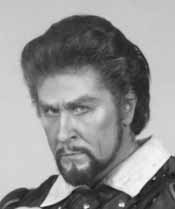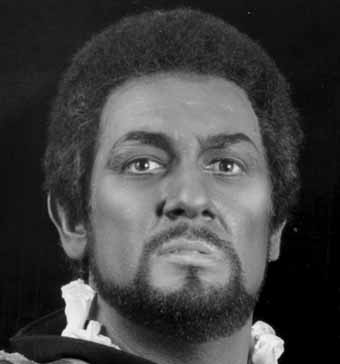Key Word Search
Multi-Field Search
Browse
Repertory Report
Performers Report
Contacts
Met Opera Website
Opening Night {95}, General Manager (Executive Director): Anthony A. Bliss
Otello
Metropolitan Opera House, Mon, September 24, 1979 Telecast
Debut : Giuliano Ciannella, John Darrenkamp
Otello (240)
Giuseppe Verdi | Arrigo Boito
- Otello
- Plácido Domingo
- Desdemona
- Gilda Cruz-Romo
- Iago
- Sherrill Milnes
- Emilia
- Shirley Love
- Cassio
- Giuliano Ciannella [Debut]
- Lodovico
- Kurt Moll
- Montàno
- John Darrenkamp [Debut]
- Roderigo
- Charles Anthony
- Herald
- Gene Boucher
- Conductor
- James Levine
- Production
- Franco Zeffirelli
- Costume Designer
- Peter J. Hall
- Lighting Designer
- Gil Wechsler
- Stage Director
- Fabrizio Melano
- TV Director
- Kirk Browning
Otello received ten performances this season.
Telecast: Live From The Met
Available for streaming at Met Opera on Demand
Review 1:
Review of Christopher Porterfield in the October 8, 1979 issue of Time Magazine
MUSIC
The Met, the Moor and the Eye
Domingo opens season in a blazing TV performance of "Otello"
As opera goers moved through the gala ritual of the Metropolitan's opening night last week, they were met with an unfamiliar sight. Television lights glared down on the huge Chagall murals and curving marble staircases. Cameras panned the red-carpeted lobby. On the Grand Tier balcony, presumably sophisticated first-nighters pressed around to gawk at Met Tour Director Francis Robinson's TelePrompter as he beamed at interviewees. The occasion was a live broadcast to public television's 282 U.S. stations, as well as to Canada and Mexico. "It's like a political convention," complained one elegant buff. At least the women who had come to be seen in their new dresses and old jewels could parade, not just for the other 4,000 ticket holders, but for an international audience of perhaps 4 million.
The real show was inside, however, and what a show it was. Audience and TV viewers alike were treated to a full-scale display of all the elements that can make opera truly grand: a masterpiece of the repertory - Verdi's "Otello" - opulent staging, brilliant conducting by Met Music Director James Levine, and a cast of top singers giving a blazing performance.
Tenor Placido Domingo was masterly in his first Otello in New York (he has performed it 40 times elsewhere and recorded it for RCA). Dramatically, he projected a strong warrior but a vulnerable man, a noble nature whose obliviousness to evil turned all his strengths - his depth of feeling, his decisiveness, his simplicity - to fatal weaknesses. The cruelly demanding role requires Otello to sing full-out the moment he walks onstage, with the famous cry of triumph, "Esultate!," and scarcely ever allows him to let up thereafter. Domingo's voice was exhilaratingly equal to it all - dark and thrusting in the declamatory passages, freely soaring in the lyrical settings.
Baritone Sherrill Milnes' Iago was a virile, magnetic figure, believable as a military officer, charming when he needed to be, capable of holding his twisted, demonic drives in check with a keen intelligence. No moment in the opera was more splendidly sung or powerfully acted than the second act "S'i, pel ciel," with Otello on his knees in a grotesquely misguided vow of vengeance and Iago looming over him with upraised hand, like a malign marionette master. In this scene Verdi transcended Shakespeare, said Shaw. Watching Domingo and Milnes, one could only agree.
The "S'i, pel ciel" is one of the biggest climaxes in a score that sometimes seems to be nothing but climaxes. But Verdi and Librettist Arrigo Boito knew that after the massive choral scene in Act III, enough was enough. Hence the rightness of the subdued, wistfully melancholy fourth act, a sort of spacious postlude. This act is Desdemona's great moment. Soprano Gilda Cruz-Romo made the most of it, although in the earlier acts her singing had somewhat lacked color and shading. Poignant and dignified, she spun out the "Willow Song" and Desdemona's final prayer in long, crystalline legatos.
Obviously the TV presence detracted nothing from the performance. It may even have helped it. Performers agree that it generates what Levine calls "a constructive nervousness," forcing them to concentrate harder. Milnes estimates that in a televised performance "the metabolism goes up 10% to 15%. You can't help thinking you're on Candid Camera." Sometimes it can be a little too candid. Last week, before Cruz-Romo's big arias, viewers could clearly see her rolling her tongue to gather saliva in her mouth ("My God," she said later, "I didn't know I did that"). But, as Domingo points out, that very intimacy can also enhance a performer's expressiveness: "Viewers can appreciate what's lost onstage - a little glance, a movement. I think we should take advantage of it."
Not only should, but must. TV cameras are in the opera houses and concert halls to stay. More and more broadcasts of live performances are scheduled, mostly for PBS. The Met, which experimented with them as early as 1948 and began them on a regular basis in 1977, will do three more this season for North America, plus one to be beamed directly to Europe. A joint Joan Sutherland-Marilyn Horne recital next month will begin the Emmy award-winning "Live from Lincoln Center" series of six vocal, instrumental and dance programs. Coverage of perhaps another dozen special events is in the offing, including the San Francisco Ballet, the Vienna Philharmonic and the Chicago Lyric Opera.
Hard-pressed music administrators, already adept at the Trustee Talk, the Backstage Rallying Cry and the Bargaining-Table Bluff, now have to add another number to their repertories: the Intermission Chat. It gets results. The San Francisco Opera has received 35,000 requests for the souvenir program it offered on a telecast of "La Gioconda" two weeks ago - some containing unsolicited contributions. To be sure, an episode of "Mork & Mindy" is seen by 44 million viewers, whereas a top-rated ballet or opera reaches only 8 million or 9 million. But this is easily twice the usual audience for a PBS show, and it is astronomical by the standards of a house like the Met that seats fewer than 4.000 a performance. Somewhere among all those viewers out there may be the new audiences that orchestras and operas need to flourish in the future. "In the long range," says the Met's executive director, Anthony Bliss, "television will become important to our survival." The benefits go both ways: the Met's opening was, for its part, a stirring and resonant contribution to television.
Photographs of Plácido Domingo as Otello, Gilda Cruz-Romo as Desdemona, and Sherrill Milnes as Iago by James Heffernan/Metropolitan Opera.
Search by season: 1979-80
Search by title: Otello,
Met careers
- James Levine [Conductor]
- Plácido Domingo [Otello]
- Gilda Cruz-Romo [Desdemona]
- Sherrill Milnes [Iago]
- Shirley Love [Emilia]
- Giuliano Ciannella [Cassio]
- Kurt Moll [Lodovico]
- John Darrenkamp [Montàno]
- Charles Anthony [Roderigo]
- Gene Boucher [Herald]
- Franco Zeffirelli [Production]
- Peter J. Hall [Costume Designer]
- Gil Wechsler [Lighting Designer]
- Fabrizio Melano [Stage Director]
- Kirk Browning [TV Director]


